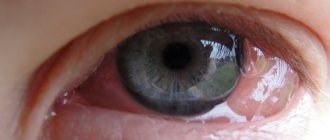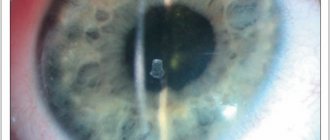What is conjunctivitis? Characteristics of the disease
Ophthalmologists call conjunctivitis an inflammation of the mucous membrane of the eye, that is, the conjunctiva. Most often, the cause of this disease is an infection, but often this inflammatory process can also be aseptic in nature.
In this article
- What is conjunctivitis? Characteristics of the disease
- Classification
- Causes of infection
- Symptoms and diagnosis of conjunctivitis
- Conjunctivitis in adults. How to treat at home?
- How to cure conjunctivitis?
- Methods Conjunctivitis in adults: treatment with ointments
- Home treatment: what is it like?
- Is it possible to cure conjunctivitis with eye exercises?
- How to treat conjunctivitis at home during pregnancy?
- Is it possible to request sick leave for conjunctivitis?
- Recommendations for the treatment of conjunctivitis in adults
As soon as you realize that you have the first signs of conjunctivitis, which we will discuss below, immediately consult a doctor, as starting the process can lead to a worsening of the disease. So why does the disease occur? The thing is that the mucous membrane of the eye performs a protective function, which means it is most often exposed to adverse external factors, including injuries and infections. When the conjunctiva is damaged or contacted by bacteria and other infectious agents, the mucous membrane becomes inflamed due to allergies. As soon as conjunctivitis appears in one eye, after a while the second eye becomes infected, since the infection tends to spread quickly. As for the symptoms, they are often approximately the same for all types of conjunctivitis:
- swelling;
- purulent discharge from the eye;
- itching;
- burning.
But this symptom may also be accompanied by others, depending on the cause of infection, for example, scarring, perforation of the cornea. Often conjunctivitis is accompanied by other inflammatory eye diseases - keratitis, blepharitis, dry eye syndrome.
Acute conjunctivitis: treatment and prognosis
Without examination by a doctor and diagnosis, it is impossible to make a correct diagnosis. This means the treatment will be ineffective. At the appointment, the ophthalmologist conducts a thorough examination of the eye shell, records changes in structure or color, and tests vision. If any discharge is present, it is collected for laboratory testing. Only after specifying the type of pathogen is drug therapy prescribed. Let's consider a treatment regimen for different forms of acute conjunctivitis.
Purulent course with a bacterial form
Be sure to use drops and ointments with an antibacterial effect. It is important to frequently cleanse the affected eye of secretions and mucus with antiseptic agents. For mild inflammation, chamomile infusion can be used. It has an anti-inflammatory effect. Medicines are selected individually, depending on the results of laboratory tests.
Atopic form
If the exact cause of inflammation is unknown, then the treatment regimen is similar to the treatment of allergic conjunctivitis. Eye drops are prescribed, which are aimed at relieving swelling, itching and inflammation. Additionally, it is recommended to take antihistamines, vitamins and immunomodulators. When an infection occurs, treatment is supplemented with antibacterial agents. It is important to identify the possible allergen and exclude it. During treatment, careful hygiene is maintained. If the mucous membrane is dry, you can take moisturizing drops. For severe sneezing, vasoconstrictors are recommended.
Catarrhal form
The basis of treatment is antibacterial drops. Every 3 hours, antiseptic rinsing of both eyes should be performed, regardless of the spread of infection. Careful hand hygiene is required before and after the procedure. With properly selected therapy, relief occurs within 2–3 days. If there is no positive result, the doctor will change the drug. Treatment period is 14 days.
Infectious form
It is important to prevent the infection from spreading, as this can lead to serious complications. Therapy includes:
- cleansing the eyes of secretions by rinsing with antiseptic solutions;
- placing antibacterial ointment inside the eyelid;
- instillation of anti-inflammatory drops;
- antibiotics (if necessary);
If the inflammatory process develops, the use of lenses is prohibited. During this period, wearing glasses is recommended. You should not strain your eyes, that is, read, watch TV and use gadgets.
Classification
First of all, ophthalmologists divide conjunctivitis into endogenous and exogenous. The former are secondary and appear as a consequence of another disease, while the latter are primary.
In accordance with the cause that caused the inflammatory process, the following types of conjunctivitis are distinguished:
- bacterial, which appears due to the proliferation of gonococci and other microorganisms;
- chlamydial, which is called trachoma or paratrachoma. Unlike other bacterial infections, treatment of conjunctivitis in adults in this case requires the additional use of systemic drugs (tetracycline, erythromycin and others);
- viral conjunctivitis;
- fungal, it appears as a result of candidiasis and other diseases of fungal etiology;
- non-infectious developing against the background of an allergic reaction or autoimmune pathologies;
- traumatic, resulting from thermal, mechanical or chemical damage to the mucous membrane.
In addition, the disease is divided according to the type of course into acute, subacute and chronic, and according to its form - into catarrhal, purulent, follicular and membranous.
Causes of infection
We answered partly about the causes of infection above: depending on the type of conjunctivitis, the ophthalmologist can talk about the routes of infection.
Thus, infection with bacterial conjunctivitis occurs through contact and household contact, for example, due to dirty hands or the use of dirty towels or other people's cosmetics. Newborns are most often diagnosed with chlamydial disease, which appears during passage through the birth canal. In adults, the cause of the pathological process is the presence of an infection of the genitourinary system. Fungal conjunctivitis develops against the background of damage to the body by molds or fungi of the genus Candida, actinomycetes and other pathogens. Non-infectious inflammations also develop as a result of injuries, irritation by aggressive factors (dust, ultraviolet radiation), autoimmune diseases, spasms of accommodation, and metabolic disorders.
Symptoms and diagnosis of conjunctivitis
As mentioned above, what the signs of the disease will be depends on the provocateur of conjunctivitis. Common symptoms look like this:
- redness and swelling;
- tearfulness and photophobia;
- pain, itching and burning;
- sensation of a foreign body in the eye;
- purulent discharge from the mucous membrane;
- blepharospasm.
In order to accurately diagnose the disease, you need to consult a doctor who, after an initial examination, will direct you to take a smear of discharge, as well as, if necessary, other tests. After laboratory tests, it will become clear what type of conjunctivitis you are experiencing, and specific treatment will be prescribed. It is possible that additional consultation with an allergist, infectious disease specialist, otolaryngologist and other specialized specialists may be required.
Symptoms
An inflammatory eye disease of a viral nature has characteristic clinical symptoms:
- redness of the conjunctiva;
- when complications occur, the disease spreads to the cornea and hemorrhage forms on it;
- swelling and inflammation of the conjunctiva;
- increased lacrimation, which, if untreated, is replaced by dryness, which leads to the formation of microtraumas and cracks in the cornea;
- absence of purulent discharge;
- increased sensitivity to the action of bright light, due to which a spasm of the eyelids is formed, the patient cannot open them;
- the possibility of a bacterial infection accompanied by the formation of purulent exudate.
The degree of manifestation of symptoms depends on the cause of conjunctivitis, the prevalence of the pathogen, the patient’s immune status, and the start of treatment. At first, the patient experiences slight redness and inflammation, which intensifies over time. If the disease is not treated promptly, the virus spreads to the cornea and internal tissues of the eyes.
Conjunctivitis in adults. How to treat at home?
Treatment of conjunctivitis is carried out on an outpatient basis, at home.
- The most important rule that must be followed is maximum sterility when using household items;
- be sure to wash your hands before handling mucous membranes;
- use only disposable cotton swabs and towels;
- do not visit swimming pools and saunas;
- Limit watching TV and working on the computer.
Most often, for the treatment of conjunctivitis in adults, a specialist prescribes: rinsing, drops or ointments, and the use of systemic antimicrobial or antiviral drugs.
As for alternative medicine, any folk remedies for conjunctivitis (rinsing with decoctions of medicinal plants, for example) can only be used in consultation with an ophthalmologist as an auxiliary one. During treatment of the inflammatory process, it is strictly forbidden to apply bandages to the eyes. They contribute to the development of complications in the form of keratitis and impede the outflow of mucous or purulent discharge.
How to cure conjunctivitis? Methods
First of all, this is washing. They are needed to cleanse the mucous membrane of contamination, as well as to perform an antiseptic procedure, thereby speeding up recovery. In most cases, ophthalmologists prescribe Furacilin in tablets, which must be dissolved in boiled water at room temperature before use. As for the procedure itself, the eye must be treated with a swab or pipette several times a day. It is important to rinse your eyes thoroughly. You can also resort to more traditional remedies, namely an infusion of black tea or chamomile, but only after consulting a specialist. Eye drops should be used antimicrobial, antihistamine, antiviral - depending on the type of conjunctivitis.
Often, ophthalmologists prescribe an ointment that the patient should put in the eyes. Why is this being done? The thing is that this type of therapy perfectly kills germs, so in the case of bacterial conjunctivitis it is the number one remedy. Among antiallergic ointments, a medicine for conjunctivitis in adults with dexamethasone is used.
Folk remedies
Traditional medicines are indicated only as complementary therapy. If they are used as the only treatment, the patient's condition may not improve and the inflammation will worsen.
Carrot
This is a vegetable rich in vitamin A, essential for normal vision. In order for it to be absorbed in the body, it is necessary to consume fats, sour cream, and yogurt. Carrots are prepared in the following ways:
- freshly squeezed juice, to which other vegetables are added, for example, celery, lettuce;
- carrots, grated, to which a small amount of salt and sour cream is added.
The vegetable can be eaten raw daily. But at the same time, it is recommended to consume fermented milk products daily so that the beneficial substances from it enter the blood.
Colloidal silver
The substance is used to prevent and treat bacterial infections. Liquid solutions are prepared from silver and instilled into the area of the conjunctival sac up to 4 times a day. It is recommended to buy a freshly prepared solution, which is prepared in pharmacies. This drug can be stored for no more than 1 month, after which it is thrown away.
Tea
It contains antioxidants that destroy pathogenic microorganisms. Suitable varieties of black and green tea. For each application to the eye, a fresh solution must be prepared. Moreover, it should not contain chemicals, flavors, additives, sugar, or lemon. The temperature of the liquid should be room temperature so as not to cause additional damage to the mucous membrane of the eyes.
Tea is used in the following ways:
- washing the eyes with cotton pads;
- Applying tea bags for up to 5 minutes.
The tea solution is also suitable for preventing the spread of bacterial infection. It is used at the first sign of eye redness.
Bay leaf
It contains vitamins C and A. Before making the solution, each leaf should be washed, as it contains dust. The sheets are placed in a glass, hot water is poured in, and left to cool.
The eyes are washed with the prepared liquid using cotton pads. If the patient decides to make lotions, gauze is dipped into the liquid and then applied to the eyes for no more than 5 minutes.
Rose
The petals of the plant contain many vitamins. To brew the solution, the petals are first soaked in warm water. Leave for 30-40 minutes. The eyes are washed with cotton pads up to 5 times a day. You can use a compress with gauze. The product not only eliminates inflammation, but also reduces pain.
Marshmallow root
The plant is used to treat infectious and inflammatory diseases of the ears or nasopharynx. The aqueous solution is also suitable for the eyes. To do this, pour the plant with cold boiled water and leave for 6-8 hours. After this, the water is decanted and drops are placed in each eye. Treatment is carried out until the clinical symptoms of the disease decrease.
Propolis
It is a folk antiseptic. An aqueous solution can be prepared from propolis. It is filled with warm water, mixed, and adjusted. After this, decant to form a liquid without solid particles. The solution is instilled into each eye up to 3 times a day. Treatment is continued until clinical symptoms decrease.
Royal jelly
For treatment, an aqueous solution based on royal jelly is suitable, which must be filtered through special paper or a bandage. The resulting solution is instilled into the area of the conjunctival sac as clinical symptoms intensify. Usually this is 4-5 times a day. Treatment is carried out for 2-3 weeks to reduce the risk of re-inflammation.
Home treatment: what is it like?
Taking into account modern medicine and the wide variety of remedies for conjunctivitis, ophthalmologists do not advise resorting to alternative medicine. However, in some cases, doctors still prescribe therapy based on herbal products to patients. Looking ahead, we note that you should resort to this type of treatment only after consultation with your doctor and after the type of conjunctivitis has been established.
It is not recommended to self-medicate, since, despite its apparent harmlessness, conjunctivitis can greatly affect the general health and health of the eyes.
Is it possible to cure conjunctivitis with eye exercises?
Gymnastics for the eyes are great for relieving tension after a hard day, as a preventative against farsightedness, myopia and astigmatism, and also works well for conjunctivitis: it helps relieve pain, but nothing more. Especially if your work activity involves constant work at the computer. What types of exercises are there? In fact, there are a lot of them, and you can find them both on the Internet and by consulting with your doctor. For example, some of the most popular gymnastic exercises are the following:
- draw circles with your eyes first in one direction and then in the other;
- rapid blinking, which improves blood circulation;
- drawing an infinity sign or a figure eight with your eyes in the air.
We should not forget about the role vitamin complexes play in the fight against disease. So, if visual acuity decreases, you should take a course of retinol-based medications, and if you need to strengthen blood vessels, a specialist has the right to prescribe an impressive dose of vitamin C.
If we are talking about such an important component as the tissue membrane, then to strengthen it it is recommended to resort to tocopherol - it is this that protects against too bright light and ultraviolet rays. Of the natural products that can be taken both with vitamins and in “live” form, ophthalmologists recommend blueberries and beets, as they contain substances for the immunity of the visual organs. Answering the question whether it is possible to work at a computer with conjunctiva, ophthalmologists answer - yes, it is possible, but only if all the above rules are observed and, of course, hygiene standards. Do not neglect the recommendations of doctors and do not self-treat conjunctivitis.
How to treat chronic conjunctivitis at home?
If conjunctivitis has acquired a chronic form (does not go away within a month), then ophthalmologists talk about pathology.
Often, chronic conjunctivitis is diagnosed against the background of blepharitis, tonsillitis, sinusitis; it is also worth noting that this type of disease can appear as a result of improper treatment or, conversely, its absence. In addition, the duration of conjunctivitis may be associated with the risks of contracting a fungal infection. That is why the treatment of viral conjunctivitis is accompanied by antimycotic drugs.
Conjunctivitis
Allergy
Herpes
Fungus
4563 06 November
IMPORTANT!
The information in this section cannot be used for self-diagnosis and self-treatment.
In case of pain or other exacerbation of the disease, diagnostic tests should be prescribed only by the attending physician. To make a diagnosis and properly prescribe treatment, you should contact your doctor. Conjunctivitis: causes, classification, symptoms, diagnosis and treatment methods.
Definition
Conjunctivitis is an inflammatory disease of the outer mucous membrane of the eyeball and the inner surface of the eyelids of various nature.
Conjunctivitis is the third most common eye disease, and in children the infection is often bacterial in nature.
According to the definition used by Russian ophthalmologists, conjunctivitis is irritation of the conjunctiva of the eye in response to various factors, manifested by redness (hyperemia), swelling and itching of the eyelids, often complicated by visual impairment due to the spread of the pathological process to the cornea - the outer shell of the eye (with the development keratoconjunctivitis).
Causes of conjunctivitis
The causes of conjunctivitis include failure to comply with personal hygiene rules (infections enter the eye mucosa through dirty hands), decreased local and general immunity, the presence of allergic diseases, as well as the use of lenses, improper care of them and the use of damaged or expired lenses.
Classification of conjunctivitis
According to
the duration of the flow,
they are distinguished:
- Acute – symptoms of the disease last less than 4 weeks.
- Chronic – the disease lasts more than a month.
For the reason
that caused conjunctivitis:
- Viral (the main causes are adenovirus, human herpes virus, enterovirus, molluscum contagiosum virus, etc.).
- Bacterial. Typically, bacterial forms of conjunctivitis develop as a result of the addition of a secondary infection to an existing viral conjunctivitis. Children are diagnosed more often than adults. Bacteria that cause the development of this pathology include Staphylococcus aureus, Haemophilus influenzae, gonococcus, and streptococcus.
- Allergic. Allergic conjunctivitis can be either an independent disease or observed together with other allergic manifestations (for example, hay fever). The following types of allergic conjunctivitis are distinguished: seasonal (for example, when weeds and trees bloom), year-round (if the allergen constantly circulates in the air - animal dander, dust mites), contact (for example, an allergic reaction to decorative cosmetics).
- Physical (due to physical or chemical exposure). When the mucous membrane of the eye is exposed to a chemical (low-quality cosmetics, household chemicals, etc.) or a physical agent (light of excessive intensity, radiation, mechanical impact on the mucous membrane of the eye), nonspecific inflammation develops.
- Autoimmune (urethro-oculosynovial syndrome, for example, with genitourinary or intestinal infections).
Symptoms of conjunctivitis
Regardless of the cause, conjunctivitis always begins acutely.
The occurrence of photophobia most often indicates involvement of the cornea in the process, which is fraught with a significant decrease in vision in the absence of proper treatment.
Viral conjunctivitis
- Herpetic conjunctivitis first affects one eye, then the infection can spread to the second. The development of the disease is sluggish, the symptoms are not clearly expressed. The appearance of swelling and redness of the eyelid is characteristic; there may be typical herpetic blisters with transparent contents; when a secondary infection occurs, a mucopurulent discharge appears.
- Adenoviral infection (pharyngoconjunctival fever) is an acute disease accompanied by a runny nose, fever, sore throat with possible enlargement of the cervical lymph nodes. Eye damage is usually gradual - first one eye is affected, and after 72 hours - the second.
- With conjunctivitis caused by the molluscum contagiosum virus, mucus secretion from the eye and the formation of nodules with a concave center on the eyelids are disturbing.
- Viral conjunctivitis is also characterized by rapid spread in crowded groups (in kindergartens, schools).
Bacterial conjunctivitis
A distinctive symptom is the difficulty of opening the eyelids after sleep due to copious purulent discharge; in the early stages of the disease, the appearance of white threads when opening the eyes.
Bacterial conjunctivitis is characterized by sharp redness of the conjunctiva of the eye, a burning sensation in the eye, a feeling of a foreign body (sand), and the appearance of pathological discharge (pus).
In newborns, gonococcal conjunctivitis can develop due to infection during childbirth. Most often appears on the 2nd–5th day of life. A similar picture occurs when a child is infected with chlamydia.
Allergic conjunctivitis The development of symptoms of the disease occurs immediately after contact with the allergen or after a short time (up to 48 hours). There is profuse lacrimation. Over time, the secretion thickens, when a secondary infection occurs, it becomes cloudy and purulent. The patient complains of itching, burning in the eyes, redness of the eyelids (the lesion is often symmetrical (both eyes at once)). Soon these symptoms may be joined by a runny nose (this is due to swelling of the nasolacrimal duct), photophobia (if the cornea is involved in the process), and decreased visual acuity.
According to the course of the disease, acute allergic conjunctivitis is distinguished (if contact with the allergen is one-time or very rare, such a disease passes quickly, in mild cases it is enough to simply stop contact with the allergen) and chronic (in this case the contact is regular, the symptoms are wave-like and less pronounced - more often with allergies to house dust mites).
Physical conjunctivitis
Symptoms of this disease develop immediately after exposure to an irritating agent: burning, discomfort, itching, sensation of a foreign body in the eye, lacrimation, redness of the eyelids and eyeball.
Urethro-oculosynovial syndrome
Urethro-oculosynovial syndrome (previously called Reiter's syndrome) develops in response to the penetration of sexually transmitted infections (in particular, chlamydia) into the body, autoimmune inflammation, when the body's own cells of the synovial membrane of the joint, the mucous membrane of the eye and the urethra are perceived by the body as foreign. In addition to the eye symptoms of conjunctivitis, the patient is concerned about pain and swelling of large joints. Conjunctivitis is often purulent in nature. It is possible to develop iridocyclitis - inflammation of the middle (choroid) membrane of the eye, including the iris, which causes pain in the eyeball and its hyperemia (redness), clouding of the cornea, lacrimation and photophobia are characteristic.
Diagnosis of conjunctivitis
Diagnosis of the disease is based, first of all, on examining the affected eye and collecting anamnestic data to identify the factor that caused the development of conjunctivitis. An obligatory part of diagnostic measures is checking visual acuity. If necessary, scrapings of the conjunctival mucosa are taken (in particular, to identify the DNA of microorganisms), culture of pathological discharge from the eye, including an expanded spectrum of antibiotics and to identify molluscum contagiosum. Consultations with related specialists (for example, otolaryngologist, allergist, rheumatologist, etc.) are often required.
How to treat conjunctivitis at home during pregnancy?
Treatment of any diseases in this case is carried out taking into account possible harm to the fetus. And conjunctivitis should be treated only after consultation with an ophthalmologist and gynecologist who is seeing the expectant mother. First, the doctor will prescribe topical medications to eliminate the disease. What works best in such cases, as in others, is ointments and eye drops.
The only condition is that the dosage should be several times less so as not to harm the fetus. Taking medications orally should be done under the strict supervision of a physician. In addition, it is worth keeping in mind that during the second and third trimester, many drugs, including hormones or drugs with high metal content, are strictly prohibited. Before treating conjunctivitis with antibiotics, you should also consult a gynecologist and therapist. During pregnancy, a woman’s body undergoes strong hormonal changes, which is why her immunity weakens, which means the risk of contracting infectious diseases, including bacterial and viral conjunctivitis, increases. Treatment of viral conjunctivitis requires special attention from not only the patient, but also doctors.
To avoid the possibility of bacterial infection, you should not use other people's cosmetics, resort to contact lenses (try using glasses) and, most importantly, you must follow all the rules of personal hygiene. Of course, before you start treating conjunctivitis at home using exclusively traditional methods, you should make an appointment with your treating specialist.
Treatment of viral herpetic conjunctivitis of the eyes
The herpes virus, having entered the human body, affects not only the skin, but also the mucous membranes, often causing herpetic viral conjunctivitis. The most common types: herpes zoster, herpes Einstein-Barr (human herpes virus type 4), less commonly - cytomegalovirus.
The course of the disease caused by any herpes is slightly different from adenovirus. It usually affects only one eye and symptoms appear more slowly. In the follicular form of herpetic inflammation, follicles are formed on the mucous membrane, while in the vesicular-ulcerative form, erosions and ulcers appear on it. A complication of this type of viral conjunctivitis is herpetic keratitis.
To treat this type of disease, antiviral drops and ointments containing interferon are prescribed: these can be the drugs Florenal, Zovirax, Virolex, tebrofen ointment, etc. If the virus has also affected the skin around the eyes, then Acyclovir may additionally be prescribed ", "Valtrex", immunomodulators.
To avoid the addition of a bacterial infection, it is recommended to use tetracycline or erythromycin ointment and antibiotic eye drops (for example, Tobrex) twice a day.
Recommendations for the treatment of conjunctivitis in adults
As a result of the inflammatory process, vision problems may arise - visibility will be difficult. Even after long-term treatment, discomfort is possible, but with proper treatment of conjunctivitis, they can be avoided. Experts say that as soon as the unpleasant symptoms of the disease pass, treatment should begin with topical agents that will help quickly restore the damaged mucous membrane of the eyes. One of the most effective drugs for mucosal regeneration in conjunctivitis in adults is Solcoseryl gel.
It works to awaken metabolic reactions in cells, as a result of which the tissues of the mucous membranes are restored faster. Treatment with this drug takes up to two weeks until the tissues are completely healed. Before using this medicine to treat conjunctivitis at home, adults should definitely obtain the advice of an ophthalmologist. However, this also applies to all other methods, including the folk ones that we discussed above.
So, in our information article we tried to answer the question as fully as possible about how to treat conjunctivitis in adults at home. First of all, you should make an appointment with a specialist, take the necessary tests and follow all instructions when taking medications. You can treat conjunctivitis at home by periodically visiting a doctor and consulting with him. Especially in cases where the condition worsens. Today, the treatment of conjunctivitis is not particularly difficult, since there are a lot of medications of various types that can solve this problem within two to three weeks.
Treatment
Doctors use complex treatment to eliminate the viral agent. Additionally, medications are used to improve the patient’s well-being. Drugs are used that act systemically on the entire body, this reduces the risk of complications.
Antiviral therapy
Antiviral agents are used that act systemically on the entire body, for example, Acyclovir, Ingavirin, Arbidol. If a virus enters the human body, it always spreads through the blood to various organs and tissues. Therefore, it is necessary to eliminate the action of the pathogen throughout the system.
To quickly eliminate the effect of the virus on the eye area, drops of antiviral agents are used. For example, Oftalmoferon, Poludan. They can be used up to 10 times a day without becoming addictive.
Antibacterial therapy
It is used if the patient's condition is complicated by a bacterial infection. In this case, purulent discharge from the eyes necessarily appears. It is recommended to use local products in the form of drops:
- Tobrex or Tobradex;
- Vigamox;
- Levomycetin.
At night, ointments are used that prevent the growth of bacteria:
- Erythromycin ointment;
- Tetracycline ointment.
It is recommended to undergo bacteriological culture first. But more often, doctors do not resort to this method, but prescribe broad-spectrum antibiotics.
Immunostimulants
Local agents are used in the form of drops, which enhance the immune response in the affected area. For this purpose, drugs containing immunoglobulin are used, for example, Interferon. The drug is used 2-3 times a day, alternating with antiviral agents.
Vitamin therapy
Vitamin complexes containing substances beneficial for the eyes are used. The drug stimulates metabolism, which enhances the regeneration of damaged tissues, including the conjunctival sac. Vitamin therapy improves the function of the immune response.
Moisturizing drops
A complication of viral conjunctivitis is drying of the mucous membrane of the eyes. This injures the cornea, microtraumas and cracks appear on it. To prevent this condition, it is recommended to use moisturizing drops, for example, Defislez, Slezin. They can be used an unlimited number of times during the day if dry eyes occur.











